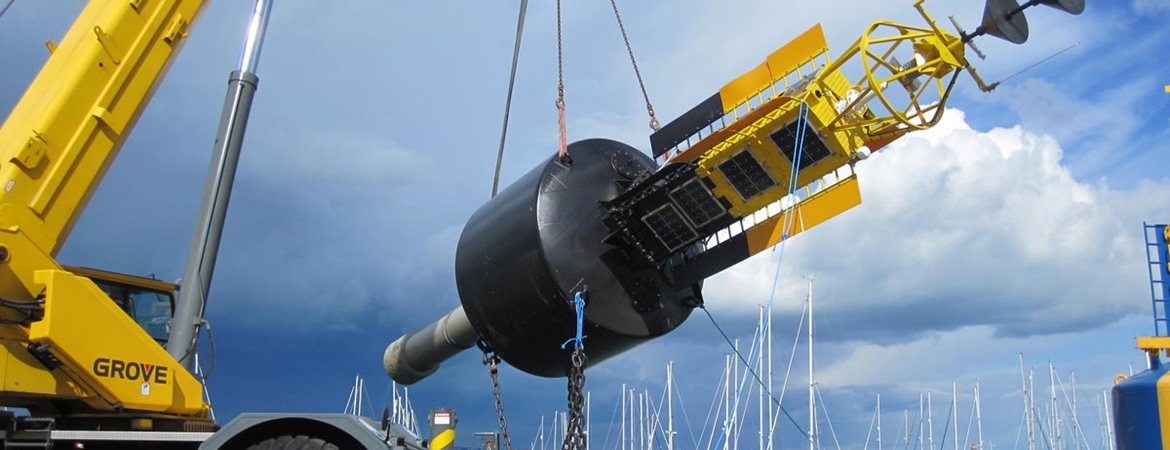Aids to Navigation – types, uses and essential precautions
We help to ensure that thousands of mariners can navigate their way safely through Irish waters. You will find here lots of information about Aids to Navigation (AtoN), including definitions of the various types, the purposes and use of AtoN – and lists of necessary precautions and ‘dos and don’ts’.
We maintains the following AtoN around Ireland:
- 64 lighthouses
- 117 buoys
- 20 beacons
- 114 Automatic Identification System (AIS) transmitters on stations
- 23 racons (radar beacons)
An aid to navigation (AtoN) is a device or system external to a vessel that is designed to enhance the safe and efficient navigation of the vessel - such as lighthouses, buoys, beacons, lights, leading marks and radio position fixing systems. An aid to navigation station may be defined as a point on the earth’s surface defined by geographic coordinates, categorised as:
- Land - a fixed station accessible by land
- Offshore - a fixed station only accessible by boat or helicopter
- Floating (buoys)
Several AtoN may be exhibited or transmitted from a single station and may comprise of one or a number of the following AtoN:
- A Daymark and or/Topmark
- Leading Mark (one of at least two separate daymark structures that provide a leading line)
- Main light
- Sector light (intensified or unintensified arc of visibility and/or colour either as part of the main light or provided in addition to the main light, in which case the term 'subsidiary light' is commonly used)
- Auxiliary light - of noticeable less intensity than the main light(s)
- Precision Direction Light - visible over a very narrow angle to indicate a direction to be followed
- Leading Light -one of at least two lights, which are situated on at least two separate structures that provide a leading line
- Emergency light - introduced upon the failure of lights, operated by a completely separate power supply; may be of noticeable less intensity than the Main Light(s)
- Racon
- Radar Target Enhancer
- Loran C and other radio navigation systems
- Differential GPS Signals
- Automatic Identification Systems (AIS)
For clarity and in accordance with terminology used by the International Association of Marine Aids to Navigation and Lighthouse Authorities (IALA), the systems provided by Local Lights Authorities and other authorities are described as "aids to navigation (AtoN)", to differentiate their provision from the equipment carried on board ships for navigational purposes. These are referred to as navigational aids (Navaids) and include Radar, compasses or depth sounders.
Fog signals are no longer considered as an aid to navigation.
Visual aids to navigation including buoys, beacons and shore-based lights are essential for safe navigation especially in confined waters.
- Many small craft rely on visual aids to navigation to check their position when in coastal waters.
- Large ships need to navigate with greater accuracy due to limited sea room, both in coastal waters and during pilotage. Fixed and floating aids to navigation are utilised in many different ways in coastal regions: to mark channels, identify hazardous wrecks, delineate safe water around shoals and to provide orientation for safe landfalls, etc.
- Most modern deep-sea ships use alternative electronic navigation systems, but navigators tend not to rely solely on one type of navigational aid. In this context, buoys provide a valuable check - both visually and on radar for evaluating situational awareness.
- During pilotage, reliance is still placed on visual AtoN, both fixed and floating, for an indication of lateral positioning, for verifying progress towards alter course positions and safe channel limits, and, in the case of floating aids, for early detection of set and drift.
- Buoys form a valuable check to mariners when operating in fog or reduced visibility, verifying electronic positioning information.
Caution: Buoys should not be used as fixed points for navigation purposes as their positions can be subject to shifting in bad weather and they can disappear due to collision. However, when used with other AtoN, correct identification of buoys provides reassurance and orientation.
Aid to Navigation types
A lighthouse is a tower, or substantial building or structure, erected at a designated geographical location to carry a signal light and provides a significant daymark. It provides a long or medium range light for identification by night. It may provide a platform for other aids to navigation such as DGNSS, racon or Automatic Identification System (AIS) to assist marine navigation. A sector light may also be incorporated into the structure.
Buoys are floating devices that are anchored in order to maintain their position and are essential in providing the mariner with visual orientation and spatial awareness. They also provide hazard, channel and waypoint marking. Equipment can be added to buoys to provide additional services such as the transmission of AIS and met hydro data.

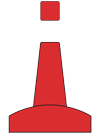
Lateral Marks are generally used for well defined channels. They indicate the port and starboard sides of the route to be followed. They are positioned in accordance with a Conventional Direction of Buoyage. Lateral Marks in region A use red to denote port and green to denote starboard. In region B the reverse applies.
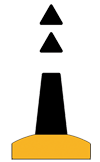

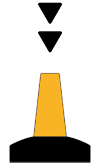
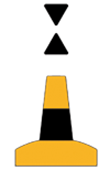
A Cardinal mark is named after the quadrant in which it is placed. The name of a Cardinal mark indicates that it should be passed to the named side of the mark. The mariner will be safe if they pass north of a North mark, south of a South mark, east of an East mark and west of a West mark.
A Cardinal mark may be used, for example, to:
- Indicate that the deepest water in that area is on the named side of the mark
- Indicate the safe side on which to pass a danger
- Draw attention to a feature in a channel such as a bend, a junction, a bifurcation or the end of a shoal
Cardinal Marks are also used for permanent wreck marking whereby North, East, South and West Cardinal buoys are placed around the wreck. In the case of a new wreck, any one of the Cardinal buoys may be duplicated and fixed with a Radar Beacon (racon).
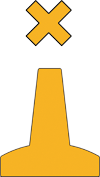
Special Marks are used to indicate a special area or feature whose nature may be apparent from reference to a chart or other nautical publication. Special marks are yellow. They may carry a yellow 'X' top-mark, and any light used is also yellow. Uses of Special Marks include:
- Ocean Data Acquisition Systems (ODAS) marks
- Traffic separation marks where use of conventional channel marking may cause confusion
- Spoil ground marks
- Military exercise zone marks
- Cable or pipeline marks
- Recreation zone marks
- Boundaries of anchorage areas
- Structures such as offshore renewable energy installations
- Aquaculture
MetOcean data systems
Met buoys are designed to improve weather forecasts and safety at sea. They provide vital data for weather forecasts, shipping bulletins, gale and swell warnings and data for general public information and research. Data Buoys are also classed as Special Marks and are coloured yellow.
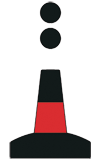
Used to mark small, isolated dangers with navigable water around the buoy. Typically used to mark hazards such as an underwater shoal or rock. They are red and black in colour.

Safe Water marks serve to indicate that there is navigable water around the mark. These include centre line marks and mid-channel marks. They may also be used to indicate channel entrance, port or estuary approaches, or landfall.

These buoys mark new wrecks clearly and unambiguously. Used as a temporary response, they are coloured in an equal number of blue and yellow vertical stripes and fitted with an alternating blue and yellow flashing light.
A fixed manmade navigation mark that can be recognised by its shape, colour, pattern, topmark, or light character, or a combination of these.
- If carrying a signal light, termed a light or lighted beacon
- If not fitted with a light, called an unlighted or unlit beacon - and provides only a day mark
- As a leading line/range or conspicuous radar mark
- May also carry a topmark
Radar + beacon. In their basic form, signals from ships’ radars trigger the racon to emit a characteristic signal which is in turn received by the ship’s radar. Their signal is in the form of a series of response pulses which will show up on a ship’s radar as a Morse-coded trace and allow easy identification of the particular racon; e.g. Kish Bank Morse code T ( - ).
Racons can be placed on any navigational mark, such as a lighthouse, beacon or buoy. The return on the ship's radar will clearly identify the mark from surrounding targets and allow the mariner to accurately measure both range and bearing. We have made major improvements in the provision of racons on the Irish coast; 22 high-specification racons are in place. The racons provided respond on standard 3cm ships' radars (X-band 9300 – 9500 Mhz) and on 10cm radars (S-band 2900 – 3100 Mhz). They are strategically placed to serve through traffic, the approaches to major ports, and fishing and leisure interests.
Leading Lights:
A group of two or more marks or lights, in the same vertical plane such that the navigator can follow the leading line on the same bearing. Leading line structures can be any colour or shape that provides a distinctive mark that cannot be confused with adjacent structures.
Precision Sector Lights:
A sector light is a fixed aid to navigation that displays a light of different colours and/or rhythms over designated arcs. The colour of the light provides directional information to the mariner. A sector light may be used to:
- Provide directional information in a fairway
- To indicate a turning point, a junction with other channels, a hazard or other items of navigational importance
- Provide information on hazard areas that should be avoided
This is an autonomous broadcast system, operating in the VHF maritime mobile band. It exchanges information such as vessel identification, position, course, speed, etc. between mobile and fixed stations. It handles multiple reports, using Time Division Multiple Access (TDMA) technology ensuring reliable and robust operation.
AIS, as applied to aids to navigation, improves and enhances services provided to Mariners.
AIS AtoN Station
The primary purpose of an AIS AtoN station is to promote and enhance safety and efficiency of navigation by one or more of the following:
- Providing a positive and all-weather means of identification
- Complementing existing services (e.g. racons) from aids to navigation
- Transmitting accurate positions of floating aids to navigation
- Indicating if a floating aid to navigation is off position
- Promulgation of Application Specific Messages including marking or delineating tracks, routes, areas, and limits (e.g. areas to be avoided and Traffic Separation Schemes); marking offshore structures (for example, wind turbines, wave and tidal energy devices, oil and gas platforms); and providing weather, tidal, and sea state data.
Virtual Aids to Navigation
- A virtual AtoN does not physically exist it's a digital information object promulgated by an authorised service provider, which may be presented on navigational display systems.
- It can be used to inform the mariner about dangers to navigation as well as safe waterways, areas in which extra caution may be necessary and areas to be avoided.
- It may be used to represent a line, area, position or other form that may be displayed graphically.
- The information, including geographic position, carried by virtual AtoN may be fixed or may be changed over time (dynamic), depending on the intended purpose.
- A virtual AtoN is used primarily where there is a time critical consideration. They may also be used in places where permanent physical AtoN cannot be sited or maintained.
Authorities, AtoN providers and mariners have long been concerned that the growing background lighting in coastal, port approach and harbour areas is reaching critical levels and often overwhelming aids to navigation (AtoN).
It is often difficult to pick out and identify the aids or it is difficult for the mariner to use channel lights. Therefore, there is a need to emphasise the navigable channel, marked routes and specific areas.
The purpose of synchronising is to increase the conspicuity of the signal, and/or to indicate that the two or more lights are associated in some manner. For example, if two buoys form a ‘gate’ in a channel, the lights on them might be synchronised to make the gate pair more conspicuous.
- Sequencing of lights is when a series of lights are flashed in a time sequence to show the geographical relationship between them. Such a set of lights is sometimes likened to a “flare path”.
- It is also possible to combine the two effects, so that, for example, if a channel is marked by pairs of buoys, the lights on each pair are synchronised, and in addition the pairs lights are set to be in sequence
Aids to Navigation Performance
We are required to operate in accordance with international recommendations and guidelines. For marine aids to navigation, the standards are set by the International Association of Marine Aids to Navigation and Lighthouse Authorities (IALA).
The method of measuring aids to navigation and the recognised availability standards are set for each category of aid by IALA. IALA states that the absolute minimum level of operational availability for individual aids to navigation is 95%. If availability of an individual aid falls below this level then consideration must be given to withdrawing it from service.
The availability of the actual aid to navigation (e.g. whether the light is flashing correctly or a buoy is on station) is calculated over a 3 year continuous period.
|
Category |
Availability Objective |
Calculation |
|
1 |
99.8% |
Availability objectives are calculated over a three-year continuous period. |
|
2 |
99% |
|
|
3 |
97% |
Requirements for Categories:
The GLAs have adopted the IALA definitions of each category of AtoN as follows:
Category 1: An AtoN or system of AtoN that is considered by the competent authority to be of vital navigational significance. For example, lighted AtoN and racons that are considered essential for marking landfalls, primary routes, channels, waterways or new dangers or the protection of the marine environment.
Category 2: An AtoN or system of AtoN that is considered to be of important navigational significance. For example, it may include any lighted aids to navigation and racons that mark secondary routes and those used to supplement the marking of primary routes.
Category 3: An AtoN or system of AtoN that is considered to be of necessary navigational significance.
Individual GLAs may further define the IALA Availability Categories if required.
Aids to Navigation – Limitations
Mariners should be aware of the following limitations of marine aids to navigation.
- Prudent mariners will not rely solely on any single aid to navigation, particularly a floating aid.
- The buoy symbol on a navigational chart is used to indicate the approximate position of the buoy and the sinker which secures the buoy to the seabed. The approximate position is used because of practical limitations in positioning and maintaining buoys and their sinkers in precise geographical locations.
- The position of the buoy can shift inside and outside the charting symbol due to environmental conditions.
- Aids to navigation are subject to damage, failure and dislocation.
- Aids to navigation may fail to exhibit their advertised characteristics.
- Mariners are cautioned not to rely solely on buoys for navigation purposes.
- Because of differences in horizontal datum, grids on charts of an area may vary from one chart to another. When plotting the positions of aids to navigation by the latitude and longitude method, the results should be checked against other available information.
- Atmospheric conditions can have a considerable effect on light transmission and the visibility of lights.
- The mariner should not rely solely on colour when using a sector light, but should verify the vessel’s line of position by taking a bearing on the light. On either side of the line of demarcation, between white and red, and also between white and green, there is always a small arc of uncertain colour.
- When the arc of visibility of a light is cut off by sloping land, the bearing at which it disappears or appears will vary with the observer’s distance and height of eye.
- AIS is like all other broadcast devices and is sensitive to radio frequency interference. It is also subject to the limitations of VHF propagation. AIS relies on Global Navigation Satellite Systems (GNSS) data for position and timing inputs; as such, it is subject to the vulnerabilities inherent in satellite navigation systems.
- All radio navigation systems are susceptible to interference (including jamming) and environmental effects, which can adversely affect their availability. Irish Lights strongly advise that no single Aids to Navigation system should be used in isolation and that users should use all alternative means available to cross check the information received.
Care when approaching AtoN
The following are some important points to be noted when approaching aids to navigation.
- The Commissioners of Irish Lights request Mariners navigating around the coast of Ireland to exercise the greatest care to avoid damage to floating aids to navigation.
- Mariners should give all navigational buoys a wide berth, always having regard for the strength of the wind and tide, and are requested to report immediately any defect in an Aid to Navigation either to the 24-Hour Monitoring Centre, telephone number +353 1 280 1996, or to the nearest Coast Radio Station.
- The Merchant Shipping Acts make provision for the imposition of a fine on any person who wilfully or negligently runs foul of, or makes fast to, any Buoy or Beacon, and for the recovery of the expenses for making good any resulting damage.
- Mariners are invited to contact our Operations and Navigation Services Department to comment on any aspect of the Aids to Navigation service or on hazards to navigation around the coast of Ireland.

